#Contemporary Jewellery 2017
Explore tagged Tumblr posts
Text
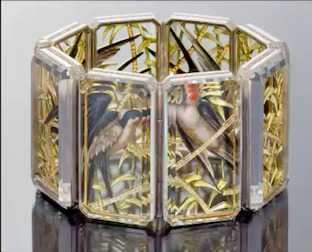
"Bracelet with Swallows" by Ilgiz Fazulzyanov in gold, quartz, diamond and enamel (2017) presented in “A History of Jewellery: Bedazzled (part 9: Contemporary Jewellery 1960s into the 21st Century)” by Beatriz Chadour-Sampson - International Jewellery Historian and Author - for the V&A Academy online, april 2024.
#conferences#inspirations bijoux#email#quartz#plumes#Fazulzyanov#ChadourSampson#V&AAcademy#Vicotira&AlbertMuseum
0 notes
Photo


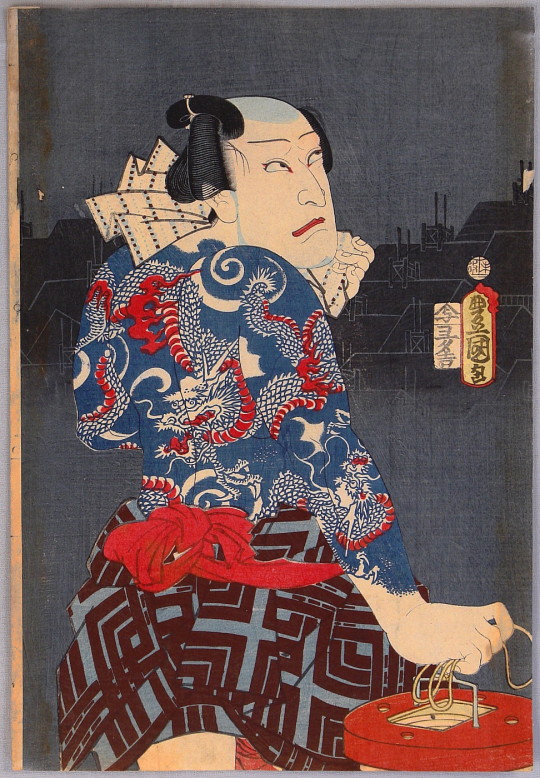
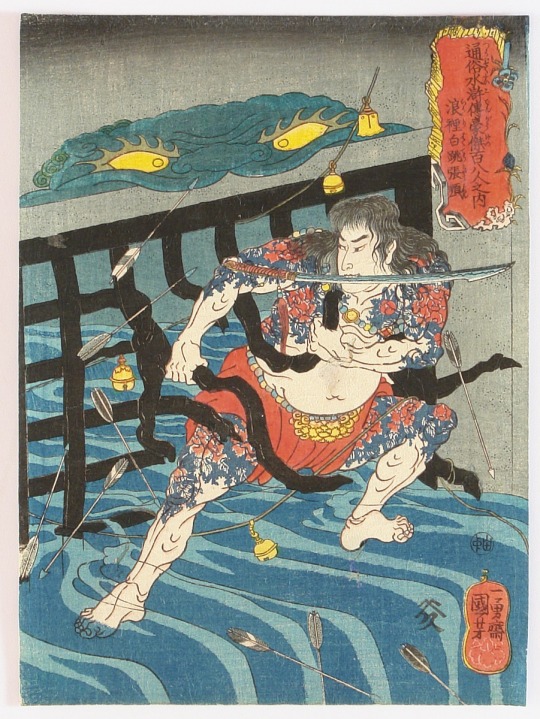
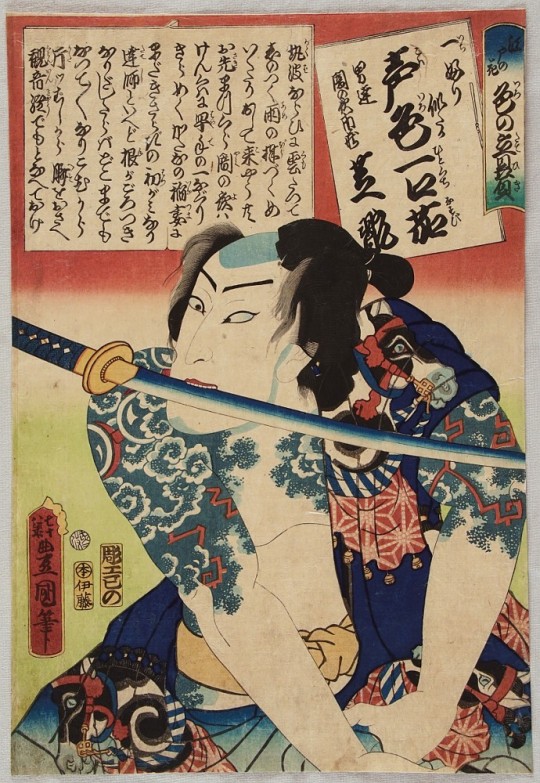

Deranged Kid (Hosai Baido, 1968-1912), Fireman of Tokyo (Kunichika Toyohara, 1868-1912), Dragon Tattoo (Kunisada Utagawa, 1786-1865), 108 Heroes of Suikoden - Tattooed Zhang Shun (Kunisada Utagawa,1786-1865), The Most Popular Actors in Edo, Their Portraits and Their Voices - Tattooed kabuki actor (Kunisada Utagawa 1786-1865), Zhang Shun, the White Streak in the Waves (Kunisada Utagawa,1827-30).
Printmaking and Tattoos
For assignment four the it asks that you consider objects that are symbolic of important to you or capture what is important to you. Although it may seem superficial to some, my tattoos are very important to my sense of self. My tattoos identify me. Without clothes, my hair, jewellery etc, I still look like me when I look in the mirror. I need to consider how I may include my tattoos within my self portrait and wanted to explore other artists who have done so.
There is a long history of crossover between printmaking and tattooing. In the above Japanese woodcuts from the Edo and Meiji period, the characters pictured are adorned with tattoos. The two mediums developed side by side as the woodblock printing exposed more people to images of tattooed heroes causing tattooing to increase in popularity. Woodblock artists and tattooists were often affiliated with each other some printmakers becoming tattooists themselves as there were shared methods and tools between the two practices. The terms for traditional Japanese tattooing include Horimono (彫り物, 彫物) which means the carving of images and Irezumi (入れ墨) insetting of ink. The term ‘Horishi’ is used for both tattoo artists and woodblock printers and translates to ‘carvers’.
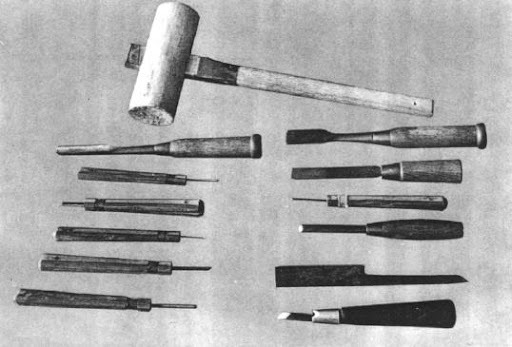
Traditional woodblock printing tools (Bull, n.d.)

Kyumonryu Shishin (Tsukioka Yoshitoshi 1868) Woodcut print depicting 18th Century Tattooing technique called ‘tebori’ wherein a set of needles is attached to a bamboo rod is rhythmically tapped into the skin depositing ink.
Traditional tattooing (Western and Eastern) uses strong line work and contrast. This is not only a stylistic choice but a practical one as bold lines help give form to colour which is more likely to fade. This aesthetic transfers well to reduction printing and many contemporary tattoo artists have explored the medium.
Alex Binnie
Alex Binnie is renown tattoo industry and an essential part of the history of the UK tattoo scene opening the first fully custom studio, Into You in 1993. Binnie’s specialism is blackwork which is characterised by strong bold line work with traditional subjects and and patterns from ancient tattooing practices (Samoan, Maori, Tibetan, Japanese, Filipino, Thai, Taiwanese, Polynesian and Indian).
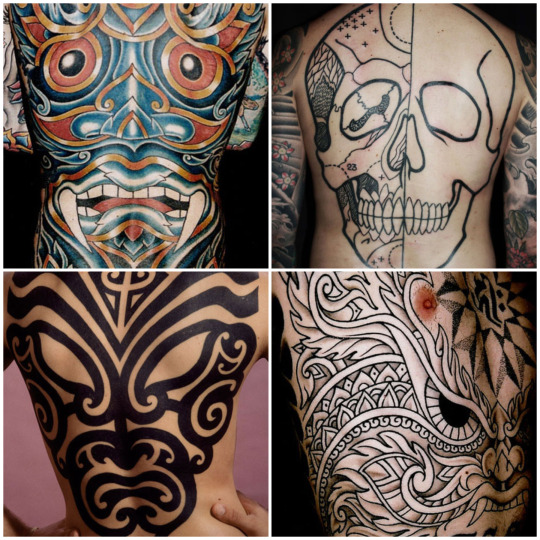
This understanding of positive and negative, black line, can be seen within his detailed woodcut prints. His is especially skilled at depicting tattooed skin, the tattoos appearing as part of the skin rather than sitting on top like a sticker. This is achieved by creating texture on the skin, rather than clearing the whole area so that it is bright white, creating a greater depth of tone. Should I wish to depict my tattoos in a realistic way this is technique would be something to bear in mind.
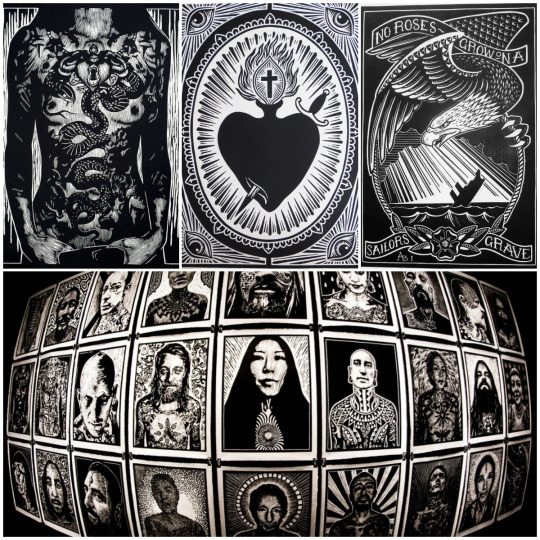
Mark Jelliman
Jelliman has a distinct style and his Japanese influenced tattoos resemble conventional printmaking techniques, in particular the the use of parallel lines to depict tone and curved form.
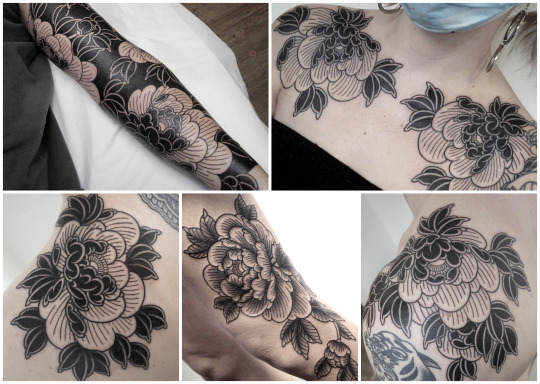
Jelliman’s linoprints are very similar to his tattooing although more symmetrical and uniform in shape (geometric shapes don’t work very well on the body as they wrap and warp). Within his printing he uses denser areas of black but continues with the parallel lines. I think his prints are beautiful and I really enjoy them however the techniques aren't suitable for depicting my own tattoos as they are high colour traditional and illustrative in design.
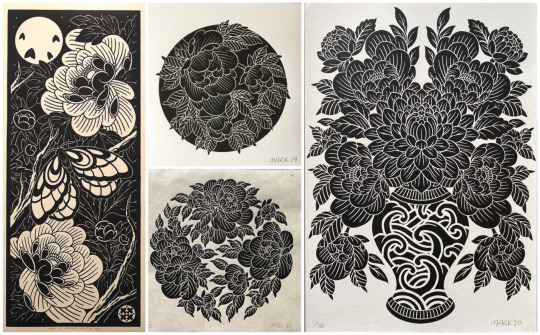
Martha Smith
Smith’s tattooing style is much finer than the previous two artists. Within her bolder outline (good for tattoo longevity) she uses delicate dotwork to create depth. This would be extremely difficult to replicate this with carving into lino or wood but perhaps it could be achieved with etching with a fine tool.
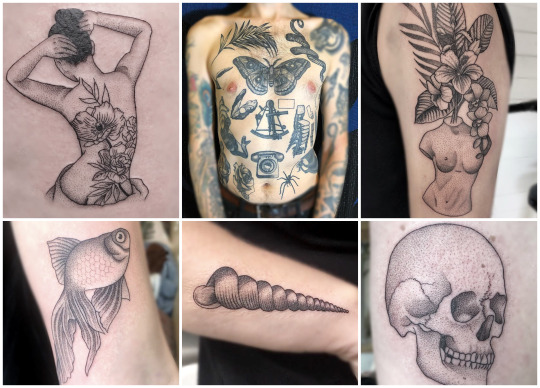
Unlike her tattoos Smith’s printing is bolder and uses stronger contrast. The addition of colour in the design of the tattooed woman is an interesting approach, the colour moving outside of the linework and even outside of the figure itself. The female torso print uses a similar technique to the portraits to Alex Binnie, using a range of fine lines to add additional depth of tone.

Sue Van Gageldonk
Van Gageldonk tattoos have a very print-like quality with high contrast and a good balance of black and white. Whereas the other artists I’ve looked at tend to keep their printmaking and tattoo work separate, Gageldonk uses one medium to influence the other, tattooing images that she created initially for prints adjusting them only slightly.


The links between the two mediums are longstanding and nuanced. Don Ed Hardy, known for his development of modern tattooing initially studied and worked a printmaker. I want to consider the relationship between the two and how I can incorporate it into my work. I'm unsure about how to depict my own tattoos within my self portrait and I need to explore the best way to do so.
References
Alexbinnie.com. n.d. Alex Binnie. [online] Available at: <http://www.alexbinnie.com> [Accessed 25 August 2021].
Bull, D., n.d. Encyclopedia of Woodblock Printmaking : Yoshida - Japanese Woodblock Printing : Chapter II : Part II. [online] Woodblock.com. Available at: <http://www.woodblock.com/encyclopedia/entries/011_07/chap_2b.html> [Accessed 20 August 2021].
Egenolf Gallery Japanese Prints. 2021. Egenolf Gallery Japanese Prints. [online] Available at: <https://egenolfgallery.com/> [Accessed 20 August 2021].
En.wikipedia.org. n.d. Irezumi. [online] Available at: <https://en.wikipedia.org/wiki/Irezumi> [Accessed 20 August 2021].
Etsy. n.d. Sue Van Gageldonk Etsy Shop. [online] Available at: <https://www.etsy.com/shop/suevangageldonk> [Accessed 24 August 2021].
Horisumi.com. n.d. [online] Available at: <https://www.horisumi.com/tebori/> [Accessed 20 August 2021].
Howerton, R., 2017. The Art of Tebori — Creating Traditional Japanese Tattoos the Old Way. [online] Tattoodo. Available at: <https://www.tattoodo.com/articles/the-art-of-tebori-creating-traditional-japanese-tattoos-the-old-way-13410> [Accessed 20 August 2021].
Iamfy.co. n.d. Martha Smith Tattoo Shopfy. [online] Available at: <https://www.iamfy.co/shop/martha-smith-tattoo> [Accessed 24 August 2021].
Japan House (Los Angeles). n.d. The Process of Woodblock Printing. [online] Available at: <https://www.japanhousela.com/exhibitions/nature-supernature/process-of-woodblock-printing/> [Accessed 20 August 2021].
Jelliman, M., n.d. [online] Marktattooist.com. Available at: <https://www.marktattooist.com/> [Accessed 24 August 2021].
Jelliman, M., n.d. Mark Tattooist. [online] Instagram.com. Available at: <https://www.instagram.com/marktattooist> [Accessed 24 August 2021].
Museum of Fine Arts Boston. n.d. Object Number 260017, Woodblock Print. [online] Available at: <https://collections.mfa.org/objects/260017/> [Accessed 20 August 2021].
Smith, M., 2021. [online] Martha Smith Tattoo. Available at: <https://www.instagram.com/marthasmithtattoo/> [Accessed 24 August 2021].
Van Gageldonk, S., n.d. Sue Van Gageldonk. [online] Instagram.com. Available at: <https://www.instagram.com/suevangageldonk/> [Accessed 24 August 2021].
Von Huban, L., 2019. "Inserting Ink": the Hidden Ties Between Japanese Woodblock Prints and Traditional Tattoos. [online] Revere Auctions. Available at: <https://www.revereauctions.com/2019/03/22/inserting-ink-the-hidden-ties-between-japanese-woodblock-prints-and-traditional-tattoos/> [Accessed 20 August 2021].
Wanczura, D., 2004. Heroes of the Suikoden. [online] Artelino.com. Available at: <https://www.artelino.com/articles/heroes_suikoden.asp> [Accessed 20 August 2021].
30 notes
·
View notes
Text


Mari Ishikawa, Rebirth-Red, Brooch series, 2017-2019, Silver 925, silk.
Mari Ishikawa’s creative approach is deeply influenced by her home culture (Japan). As a jewellery artist, she uses objects to record the moment, to depict a scene, to tell a story. To me, her jewellery is a poem that is rich in oriental philosophy while resonates with modern aesthetics.
In her work, "relationship" is a constant subject. The connection between pattern and medium, the individual mind and the outside environment, and feeling and the final piece are all carefully implanted in her designs. Red is also widely utilised because this colour has a range of significant implications in Japanese culture, including the sunset, sacred sites, rituals, and family bonds. I found the brooch series Rebirth-Red is especially intriguing. The bright red thread tangled and intertwined with the dense black tree-like structure, reminds me of blood vessels. The colour red represents good luck and blessing in oriental culture, which echoed with the name ‘Rebirth’.
Ishikawa’s own identity is also strongly referenced in the materials she chose. Her jewellery-making includes a wide range of traditional craftsman materials. For example, applying Japanese Kozo paper and lacquer, as well as silver and silk, to create a sculptural work that resembles lace, wave, and knots. By combining traditional techniques with the contemporary format, Ishikawa’s artworks exhibit a unique blend of western and eastern cultures.
4 notes
·
View notes
Text
Best Vanilla Perfume That Scent Wonderful
Save if you shop for vanilla perfumes with these Feel Unique low cost codes. Save whenever you shop for vanilla perfumes with these Selfridges low cost codes. This makes use of real vanilla from Madagascan Bourbon vanilla pods, blended with herbaceous cypriol https://www.lavanila.com/products/the-healthy-fragrance-pure-vanilla.
There’s a distinctive boozy and smoky character to the scent that’s not present in any other scent. Since 2017, “Mon Guerlain“, has been one of the top-selling vanilla perfumes. There isn't any denying the reality that Guerlain is a real legend of the perfume business. The home of Guerlain was established in 1828, giving it a historical past of just about two centuries.

This vanilla fragrance even cuts by way of cold air whereas still not being overpowering in a closed office setting. Yet, it’s best suited to a crisp spring or autumn day. This pure vanilla perfume takes inspiration from the notes of a woman. It’s composed of traditional fragrance notes related to femininity and softness. The smell of Black Opium derives from a magnificent mix of pure vanilla and coffee. The help of the principle accords comes from varied floral vanilla perfume notes.
Tobacco Vanilleeventually dries right down to a candy spicy creamy vanilla… mixed with dry tobacco leaf and woody dried fruity notes. This is unisex and greatest suited for fall, winter and cooler spring days. Coco Blanc opens up with a blast of sweet creamy white chocolate combined with rich smoky vanilla and hints of nutmeg and heat chai spices. Vanilla pods are harvested earlier than they’re ripe, after about 8 months.
Mexico has thus maintained vanilla manufacturing monopoly for nearly two centuries.
All our fragrances are expressed in distinct universes, and every of them will invite you to a unique voyage manifested by the inventive freedom of an distinctive perfumer.
You feel vivacity from the top notes that instantly transport you, a vivacity in complete contrast with delicate and tender vanilla.
I would describe Vanille Fatale as a scrumptious vanilla perfume.
The wordVanillais derived from the Spanish word Vaina, which interprets to Little Pod. Although this is called a Cologne Absolue,it's in reality, pure fragrance concentrated at 15% – which gives excellentlong-lastingperformance. As it settles, the jasmine fades away quickly… and the sweetness is balanced out completely with a hint of incense and some woodiness. This is unisex however leans slightly feminine and greatest for fall and winter utilization. Orchidée Vanille is part of their exclusive luxurious Collection Extraordinaire –that use super high-quality raw components. Van Cleef & Arpelsare a French luxury jewellery, watch and fragrance company.
Pacifica's perfumes are micro-batched using the best natural grain corn-based alcohol, each incredible scent is rigorously crafted to take you to the places of your dreams. The nuances on this scent make it a straightforward alternative for a every day perfume. You’ll scent like a bubble of vanilla that’ll please all people in your neighborhood. For a long-lasting trace of vanilla, this is our top choice.
Best Vanilla Perfume That Scent Wonderful
It lifts your mood, brings euphoria and relieves stress. Vanilla is obtained from vanilla pods that might be found on a beautiful orchid flower with yellow blossoms. Originally from Mexico and beloved by the Toltec and Aztec cultures, it can now even be discovered within the Caribbean, Indonesia and on Madagascar – the most important producer of vanilla on the planet. “Chergui” by Serge Lutens is a fantastic unisex vanilla scent. It’s the proper match for ladies and men who take priority in having an aura of elegance to them.
youtube
Cortez and his men were greeted by the Aztecs of Tenochtitlan City with a welcome beverage. Mexico has thus maintained vanilla production monopoly for nearly two centuries. Once your order is dispatched, you'll obtain a Tracking & Advice notification by way of the e-mail tackle you offered , or a text message if you offered a cell quantity.
Perfect for dates, special occasions, romantic evenings, nights-out and even informal. This is extra for the mature crowd – recommend 20-up. …A vary of fragrances for aficionados of rare scents and these that respect noble uncooked materials. And… finally, the white chocolate vibe fades and it becomes more of a musky milky vanilla with a hint of nutmeg. This additionally permits the fragrance to continue to odor higher and higher with time – identical to a nice wine ages.
Perfume Oils Discovery Set
This scent from indie fragrance darling duo D.S. & Durga might not seem like a vanilla perfume within the slightest, however be patient—you’ll see why it made this list after letting it settle into your skin. With prime notes of oleander and grapefruit, and heady coronary heart notes of cream lily and Egyptian jasmine, it smells like fog after a thunderstorm, or morning dew on freshly mowed grass. But it’s the base notes that make it really special—liquid ambrette seed and vanilla will linger on your for hours like a hazy daydream. It was the final fragrance created by the fashion house under Tom Ford’s path. As you'd count on, YSL Cinema is a smart and complex scent that deftly avoids vanilla perfume stereotypes.
It goes along often with other spices to disclose a heat and sensual fragrance. This is why we can discover it in most of oriental fragrances. Associated with gourmand notes of caramel, cakes or liquorice, vanilla is good and easy. This cult ingredient also matches nicely with the olfactory family of woody perfumes to create deep juices rich in velvet notes. Finally, with a floral or citrus coronary heart, vanilla will take you in a cool wake to wear in any season. The smoky notes of tobacco mix harmoniously with the wealthy white vanillic notes.
The high choices come from numerous value ranges and backgrounds. Each of the top vanilla-scented perfumes on this record has a distinct tackle the odor of vanilla. This complex fragrance layers an array of vanilla notes, including vanilla orchid, vanilla liqueur, bourbon vanilla and vanilla musk, as nicely as heliotrope, daylily, sandalwood and amber. Replica Coffee Break features the sweetness of vanilla unexpectedly mixed with a blend of light musk and contemporary spearmint. After some time on the pores and skin, this scent subtly transforms into notes of heat espresso and milk. It is essential to do not forget that these results have solely been documented for pure vanilla fragrance – not perfumes containing a blend of vanilla and other notes.
Tahitian Vanilla is excessive in heliotropin– which provides the vanilla an attractive fruity floral vibe and is significantly more expensive thanBourbon vanilla. Today three primary species of vanilla orchid are grown globally for the production of natural vanilla. Synthetic vanillin and vanillin extracted from real natural vanilla pods are the identical compound. They could be boozy, they can be candy, they are often smoky, they can be powdery, they can be floral, they can be fruity, they are often spicy and even a combination of these.
Carner are a Spanish luxury niche fragrance home based in Barcelona. Perfect for special occasions, dates, nights out, formal and is figure protected. The perfume is hand blended in small batches, by the creator and perfumer Christi Meshell– and she selects and makes use of only the highest high quality 100 percent natural ingredients out there. Bourbon vanilla has a mild woody and smokey aroma. Everyone knows the sweet, invigorating and thrilling scent of vanilla which has been used as thefragrance of seduction for ages.
Impactful and memorable, Nest’s Midnight Fleur Eau de Parfum combines exotic woods, black amber, and patchouli with the heat of vanilla orchid. Delicious and candy, this scent can also be obtainable in a rollerball model for individuals who want just a contact without committing an excessive quantity of. Vanille Fatale is the perfect combination of roasted espresso absolute, narcissus, and frangipani and provides off significantly seductive smoky glamour vibes. [newline]User critiques examine this scent to the feeling of being embraced in heat cashmere nestled subsequent to a flickering fire. With its heat, spicy, and woodsy combo, this perfume is perfect for nights out in town, with skyscrapers and city lights serving as the backdrop.
A unique blend of artful essences from our Small Batch Perfumery. By browsing our web site or closing this message, you agree to store Cookies by us and third-party companions. Cookies enable sure features on our web site, let you entry your account, place orders, enable us to analyse web site visitors and usage, and personalise content material. We also share sure information about your utilization of our web site with analytics partners.
In this women’s vanilla perfume, classic feminine notes give the wearer an aura of sophistication and sophistication. It’s the most effective vanilla perfume for ladies on the lookout for a singular mix of luxury and casualness. Despite the prominence of vanilla scents in perfumery, vanilla perfumes aren’t always easy to get right. That’s why we now have created this exhaustive listing of the most effective vanilla perfumes.
It’s primarily based on caramel and vanilla, giving it an nearly edible aroma. And, the gourmand notes are a perfect match for fun-loving, youthful and confident ladies. I would describe Vanille Fatale as a scrumptious fragrance. So scrumptious, actually, that I’m afraid in the future I will mistake it for something edible.
The intoxicating scent that seemed to embody sophistication, sweetness, and sexiness all at once? No one ever informed me I smelled scrumptious, but each time I spritzed myself, I felt immediately extra desirable . Our fragrances are made with top quality natural and botanical oils that ship long-lasting, alluring scent. A signature mix of pure important oils, nature identical oils, and botanically derived aromas.
Uncover the principles of perfume etiquette and discover how to spritz like a perfume connoisseur. Our perfumes are micro-batched utilizing the best natural grain corn-based alcohol. A latest experiment has shown that almost all of us, unlike Proust, have some problem in expressing this huge structure of recollection in words. Subjects were introduced with visual , lexical and olfactory stimuli, and asked to put in writing down no matter got here into their heads. Written responses to the visible and lexical stimuli were much longer than these for the olfactory mode, but responses to the odours had been way more emotive, and all referred to memories.
3 notes
·
View notes
Text
A Landmark Exhibition of First Nations Fashion
A Landmark Exhibition of First Nations Fashion
Textiles
Sasha Gattermayr

From left: Rayarriwarrtharrbayingathi Mingungurra Amy Loogatha; Alison Kirstin Goongarra; Dorothy Gabori; Agnes Kohler; Grace Lilian Lee – (collaborator) Burrkunda, dress 2017. Synthetic polymer paint on cotton. Collection National Gallery of Victoria. Photo – Leon Schoots.
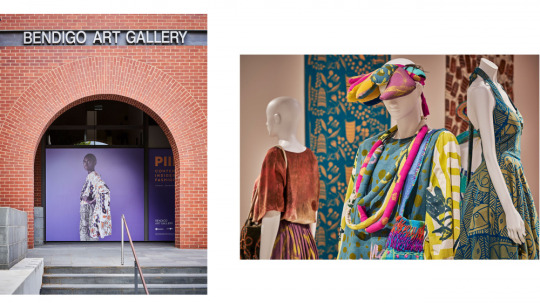
Left: The entrance to Bendigo Gallery. Right: Pieces by Trudy Inkamala, Beautiful, all my ideas, dress, bag, necklace, head piece 2019. Cotton, calico, woollen blanket, wool. Courtesy of the artist and Yarrenyty Arltere Artists. Photo – Leon Schoots.
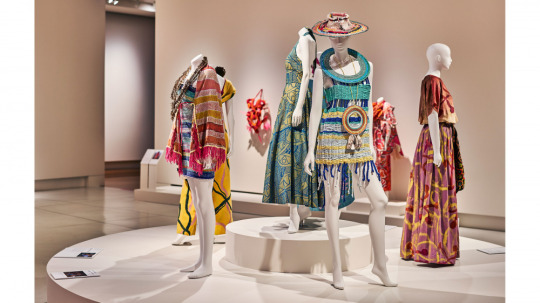
Elisa Jane Carmichael garments displayed alongside Yarrenyty Arltere Artists collection. Photo – Leon Schoots.

Arkie Barton’s Rainbow Dreaming dress; Dreamtime jacket and Spinifex flares displayed alongside Shannon Brett’s Femme gem dress. Photo – Leon Schoots.

Lyn-Al Young, Ngoorntook (winter) 2020. Photo – Leon Schoots.

Photo – Leon Schoots.
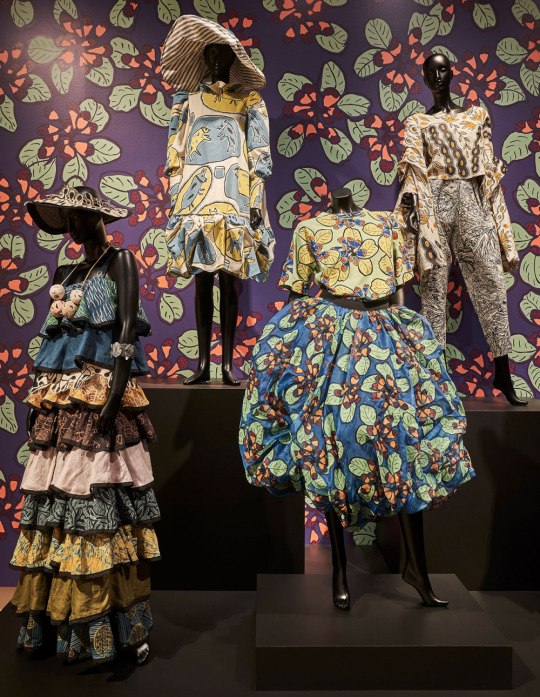
Peggy Griffith’s Legacy Dress displayed alongside garments from Hope Vale Arts and Cultural Centre x QUT Fashion. Photo – Leon Schoots.
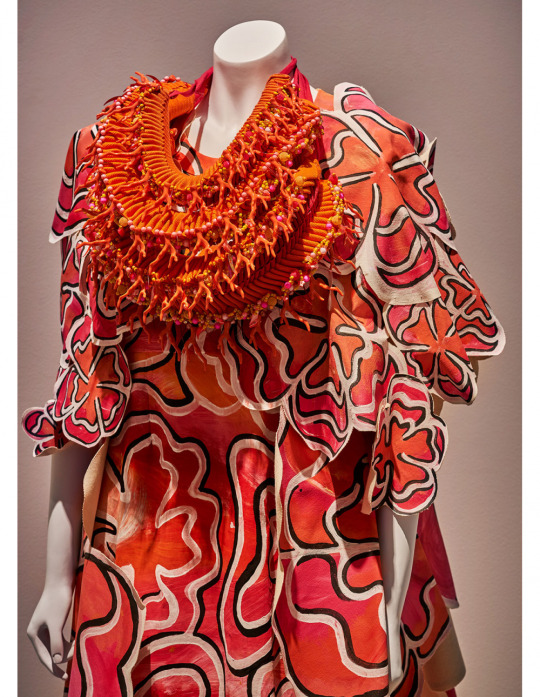
Grace Lillian Lee, Hibiscus Sunrise – 1/4. Cotton webbing, assorted beads and corals, canvas, cotton drill, permaset paint. Photo – Leon Schoots.

Margaret Rarru’s Madonna bathi and Madonna bra is displayed alongside Maara Collective x Bula’Bula Arts collection. Photo – Leon Schoots.

Melba Ngarridjdjan Gunjarrwanga and Deborah Kamanj Wurrkidj textile prints. Courtesy of the artists and Bábbarra Women’s Centre. Photo – Leon Schoots.

Grace Lillian Lee, A weave of reflection – 1/5 2018. Cotton webbing, cane, goose feathers, cotton yarn. Photo – Leon Schoots.

A main room of Piinpi: Contemporary Indigenous Fashion. Photo – Leon Schoots.
Stories of Country, culture and ancestry have been told through textiles by Aboriginal people for thousands and thousands of years.
Shonae Hobson is a Southern Kaantju woman from Coen on the Cape York Peninsula in Far North Queensland, and she’s also the First Nations curator at Bendigo Art Gallery on Dja Dja Wurrung Country. Here, she has curated a world-first exhibition, Piinpi: Contemporary Indigenous Fashion.
‘Indigenous fashion is so diverse, with many artists and designers working in a variety of mediums and styles,’ Shonae says, explaining the concept driving the show. ‘For me, it was about bringing together a selection of works that showcased the nuances of our material culture, as well as the richness of and innovation of Indigenous fashion and design today.’
The word piinpi is an expression from east Cape York used to describe the natural regeneration of the landscape that arrives with seasonal flux. Rather than follow a western exhibition structure (which is typically organised along linear concepts such as chronology or regionality), Shonae organised her featured works according to season. As a result, the show is deeply seeded in Indigenous knowledge.
‘The exhibition is based thematically on Kuuku Ya’u seasons and the show has been curated with the intention to take audiences on a journey across Country,’ says Shonae. ‘Common themes including bush foods, resourcefulness and sustainability are all conveyed through the artists’ designs.’
The exhibition is sectioned into Dry, Wet, and Cool seasons linked by the contemporary engagement of traditional practices. The Dry season exhibits work harvested from the land, such as materials tinted with natural earth dyes or baskets made from dried pandanus leaves. The Wet season signifies heavy rainfall and regeneration, and features hand-painted garments and basketry in vibrant colours. The Cool season is a time for being on Country to gather materials, and is represented with bush dyed textiles, shell jewellery, and possum skin cloaks.
Among the highlights are five new works by Gunai, Wiradjuri, Gunditjmara and Yorta Yorta woman and artist Lyn-Al Young, commissioned by the gallery specifically for Piinpi. Lyn-Al practices an ancient singing process when crafting the garments for her eponymous label, LYN-AL. Guided by her ancestors, she follows songlines and imbues the elements of her dyed silk pieces with positive words and energy.
The exhibition also represents the First Nations designers working in urban centres. Featuring the work of Teagan Cowlishaw (of AARLI Fashion), Maree Clarke, Lisa Waup and Shannon Brett (of Lore), the streetwear section of Piinpi displays the designers seeking to reclaim Aboriginal identity through contemporary fashion. This part of the exhibition recognises the Blak artists in urban areas using wearable fashion to make statements of resistance against colonialism.
‘The space is being led by Indigenous people when, for so long, our stories and histories have been told through the lens of the coloniser,’ Shonae says of the rapidly growing First Nations fashion community. ‘What we are seeing with the Indigenous fashion industry is a new wave of cultural leaders and artistic innovators who are really shaping the future of the industry, and making important statements through their work.’
‘Piinpi: Contemporary Indigenous Fashion’ will be exhibited from 12 November, 2020 – 17 January, 2021 at Bendigo Art Gallery. See more information here.
21 notes
·
View notes
Text
The Cannes Film Festival Collective Best Dresses
Another glamorous occasion that will be greatly missed over the next month, the gathering of film, actors and A-Listers alike heading to the Cote d’Azur for world class premieres for the Cannes Film Festival. Undoubtedly, the most captivating showing of all remains the red carpet display from the attendees. Join me as I revisit my favourite ensembles over the years...
1. Kendall Jenner in Giambattista Valli Couture, 2017


A look that encompassed an asymmetric design, exaggerated sleeve, floral prints, a fitted skirt, dramatic flowing train and perhaps most intriguingly... hosiery with silver strapped sandals. Kendall’s statement look oozed an effortlessly cool appeal with a couture twist. She finessed her ensemble with a half-down sleek bun, glowing glam and diamond earrings.
2. Kendall Jenner in Schiaparelli, 2018


Kendall proved she’s not shy when it comes to sheer. Her Schiaparelli dress was made up of bounds of layered ruffled tulle, cinched in with a belt. Her statement ensemble was complete with her symmetric up do, flawless makeup look and a pop of colour courtesy of her drop emerald earrings that rested carefully on her ruffled sleeves.
3. Irina Shayk in Atelier Versace, 2017


Irina jetted to the South of France for her returning debut after giving birth to her daughter only 6 weeks before. Her astonishing figure was accentuated in the glistening lemon Versace number that included a plunging neckline and thigh-high split. She boasted a sun-kissed tan, dewy complexion and her glossy hair framed her face with loose curls.
4. Bella Hadid in Dior, 2018


Bella’s ethereal dusky pink gown commanded attention for all of the right reasons. Delicately form-fitting but with a dramatic full skirt, her blush dress offered a classic design and was accessorised with a diamond choker and matching bracelet. Her locks were sleek and straight whilst her effortless makeup accented the hue of the gown.
5. Hailey Bieber (then Baldwin) in Roberto Cavalli, 2018


Marrying together rose-tinted hair, glam and a dress has never looked so elegant. Hailey’s dress had a nude bodice underneath heavily embellished blush detail and fell into a sheer fishtail train. She added silver diamond drop earrings which complemented her tousled up do and picked up silver hue crystals in the dress. Pink hair for a red carpet look? Certified.
6. Elsa Hosk in Alberta Ferretti, 2017


The Victoria’s Secret Angel’s features offer a princess-like resemblance, so it was only natural for her to grace the red carpet in a gown that favoured Cinderella. Her ensemble offered a sultry appeal courtesy of the shoulder-less design, thigh-grazing split and Hollywood waves. The diamond drop earrings added a touch more glamour to her timeless aesthetic.
7. Blake Lively Atelier Versace, 2016


The actress is now renowned for her memorable red carpet ensembles and this look was no exception. Complete with a radiant maternity glow, Blake wore a blush Versace dress that had carefully placed cutouts throughout and a glamorous fishtail train. The blonde bombshell kept her hair in loosely waved tresses and opted for soft glowy makeup with a candy pink lip.
8. Sara Sampaio in Zuhair Murad, 2018


Sara truly embodied the Arabic meaning of her name ‘Princess’ in Lebanese designer Zuhair Murad’s red carpet creation. The bare shoulders offered a contemporary twist to the traditional silhouette and the gradient pattern added interest to the glistening gown. She swept back her hair and added gold Chopard earrings for that picked up the rose gold hues in the dress.
9. Madison Headrick in Ashi Studio Couture, 2019


If there’s ever an opportunity to don an opulent statement dress, this is it. Madison was a vision in fuchsia pink. The asymmetric, voluminous skirt, belted waistline and one-shoulder design oozed glamour. Letting the dress do the talking, she kept her glam simple and added only delicate silver jewellery.
10. Bella Hadid in Roberto Cavalli, 2016


As a fresh face to the festival at the time, Bella certainly made her debut memorable. The heavily embellished and snake embroidered nude Cavalli dress complemented her complexion perfectly. Her unmissable de Grisogono choker was the perfect addition to the look and was on full display courtesy of her sleek ponytail.
#cannes film festival#cannes#red carpet#Kendall Jenner#bella hadid#hailey bieber#Blake Lively#madison headrick#sara sampaio#elsa hosk#Irina Shayk
15 notes
·
View notes
Photo
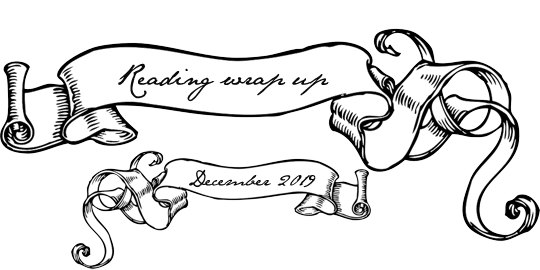
The Life and Adventures of Santa Claus
Author: L. Frank Baum
First published: 1902
Pages: 176
Rating: ★★★★☆
How long did it take: 2 days
Since I am from a country where Santa Claus is not the one to bring the presents and instead I see him as an intruder who tries desperately to butt into our traditions, I was unsure if I wanted to read this. But thankfully L. Frank Baum managed to fabricate the history of Santa in a way that was utterly charming and actually could be labeled as middle-grade fantasy. I truly enjoyed myself!
Wildwood Dancing
Author: Juliet Marillier
First published: 2006
Pages: 432
Rating: ★★★★★
How long did it take: 6 days
Snuggle up in your comfy armchair, and with the snow falling outside and a warm cup of tea beside you just plunge into Wildwood and be swept away. This is a wonderful retelling of several different fairytales, rich in imagery and using the picturesque Romanian countryside as a setting. The characters are endearing (or frustrating when they need to be) and the atmosphere sizzles with magic. The strong bonds between the five sisters, out of whom none is left out of the story, on top of the romantic attachements, succeed in making one emotional and truly invested. Simply wonderful!
With the Fire on High
Author: Elizabeth Acevedo
First published: 2019
Pages: 400
Rating: ★★★★★
How long did it take: 3 days
Perhaps this is not the most amazing book ever, but I still decided to give it 5 stars because... 1. it was everything I needed at the moment 2. the characters were strong, easily recognizable from each other and somebody I would love to know 3. it appreciates the difficulties of normal life, without need to go overboard with the drama 4. the author does not waste time and has no patience with useless fillers 5. I tend to hate contemporary stuff, or I get easily bored by it, but this book made me just feel fuzzy and and happy and comfortable
Tichá srdce
Author: Alena Ježková
First published: 2013
Pages: 456
Rating: ★★★★★
How long did it take: 13 days
Jedinečná publikace s trochu zavádějícím názvem, jelikož všechna srdce, která jsou v knize představena, nejsou ani trochu tichá, ale hovoří jasně a přesvědčivě. Alena Ježková představuje čtenáři nejen historii řádů, které někdy působily v Čechách (a v jiných částech republiky), nejen osudy klášterů, těch zvláštních míst, kde čas jako by stál navzdory tomu, že historie se jimi prohnala (většinou značně nevybíravě a nemilosrdně), ale především dává možnost získat unikátní perspektivu a náhled prostřednictvím řeholníků a řeholnic. Nejvíce ze všech získaly můj respekt sestry Boromejky. Vše je bohatě ilustrováno černo-bílými fotografiemi a celkově se tak jedná o velmi krásnou knihu, kterou je nejlépe číst pomalu.
Women & Power: A Manifesto
Author: Mary Beard
First published: 2017
Pages: 116
Rating: ★★★★☆
How long did it take: 1 day
Illuminating and disconcerting.
Papa Panov's Special Christmas
Author: Lev Tolstoy
First published: ?
Pages: 13
Rating: ★★★★★
How long did it take: 20 minutes
... and thus Lev Tolstoy made me teary-eyed with less than 15 pages.
A Christmas Carol
Author: Charles Dickens
First published: 1843
Pages: 144
Rating: ★★★★★
How long did it take: 2 days
Although I have been familiar (in great detail actually) with the story, it took almost 33 years of my life to actually read the original text. It also happens to be my first taste of Dickens. My, did he know a lot of words! The Christmas Carol, no matter how over-exposed to the public psyche for over a century, breathes a true Christmas spirit (Ha! See what I did there?), warms your heart and will surely withstand all the further tests of time.
Once Upon a River
Author: Diane Setterfield
First published: 2018
Pages: 464
Rating: ★★★★★
How long did it take: 10 days
This book is a love song: for the river Thames, for the art of story telling and for everything that makes us good as people. A kaleidoscope of characters, most of whom you grow to love throughout and feel so close to that their plight will eventually move you to tears and make you rejoice whenever they get to be happy. The story had a long, long and slow beginning, resembling, in a way, the river itself, and much like it it grows on strength until it obliterates everything with a flood of beautiful language and shimmering mystery. Love, love, love.
Marie-Thérèse, Child of Terror: The Fate of Marie Antoinette's Daughter
Author: Susan Nagel
First published: 2006
Pages: 418
Rating: ★★★★★
How long did it take: 14 days
There is really nothing I can fault with this biography, except perhaps one needs to keep in mind that a book about Marie Therese will naturally try and present the events of her life as she saw them - and at times that can be problematic. Other than that the books does exactly what it sets out to do: it presents facts and paints a picture of an interesting (if politically largely unimportant) person from before her birth to her death, never really deviating from that goal, and it is quite informative as well as fairly easy to read.
Olga's Egg
Author: Sophie Law
First published: 2018
Pages: 314
Rating: ★★☆☆☆
How long did it take: 8 days
Unfortunatelly this ranks among my most disappointing reads of the year. The premise of the book - searching for a lost Fabergé egg that once belonged to Grand Duchess Olga Nikolaevna, while battling through personal tragedy and multi-generational story - was actually great. However a subject like that needed so much more work and depth and length than it was ever given. This could (and should) have been a 500+ page epic delving into the Russian psyche covering different genres from mystery, doomed romance, historical ficton and a detective story. Instead it merely touches and lets go of all these, does not excell in any and leaves you completely unsatisfied. The search for the egg is completely straightforward with no proper secrets, no dead-ends are encountered, and the main protagonist is given everything on a silver platter on her very first try (the fact that another person, not nearly as involved or knowledgable, comes to the same conclusion as her in no time makes it all even more yawn-worthy). Some of the scenes in the book are absolutely useless. Example: we learn something had happened. Next scene shows you exactly what you have just found out. With no other info added. I was also confused as to why did the author insist on renaming an actual historical character of English tutor to the Tsar´s children Charles Sydney Gibbes, given that no other change to his biography was made. The ending is completely unrealistic, anti-climactic, and the sugary-sweet epilogue unneccessary. The ammount of "non-fiction" information thrown into the book feels forced and pretentious due to its shortness. What a bummer.
The Regalia of the Russian Empire
Author: Irina Polynina
First published: 1994
Pages: 240
Rating: ★★★★★
How long did it take: 2 days
Excellent and beautiful volume which combines interesting facts with high-quality photographs and picture reproductions. Absolutely would recommend to anyone with interest in Russia, the Romanovs, jewellery or just history in general.
The Starless Sea
Author: Erin Morgenstern
First published: 2019
Pages: 498
Rating: ★★★★★
How long did it take: 5 days
Have you ever finished a book and you realized your hands were shaking and you had tears in your eyes simply because it was too beautiful? Because I have not - until The Starless Sea. More of my emotional breakdown HERE.
6 notes
·
View notes
Text
Creative Industries
The creative industries provides a broad range of wealth and opportunity. Every sector below consists of cheap and expensively made projects. It is a way to reach people and supply entertainment in some cases.
Information on existing examples of all the major sectors within the Creative industries (company websites/ profiles for example) with brief written explanations of them:
Advertising - This is a sector that produces strategies to promote products and companies, and example of a well known advertising brand is bartleboglehegarty.com/london responsible for many famous TV adverts such as ‘The Lynx Effect’ and Audi's 'Vorsprung durch Technik'.
Games - This sector consists of interactive programs on screens. https://www.rockstarnorth.com developed the famous grand theft auto in Dundee and Edinburgh. Three main game console companies are called Wii, Xbox, and PS4.
TV and Film - This is a visual medium that provides entertainment and information seen in cinema, DVDS, and broadcasted programs. https://www.bbc.com/aboutthebbc/ is responsible for being the one of the main providers on the planet producing news, programs, and adverts.
Arts and Culture - Everything below is part of the Arts, however this sector is specific to performing and visual arts like theatre, museums and galleries. The Arts span from traditional to contemporary, a famous gallery is the https://www.louvre.fr/en/ ,Earth’s biggest Art museum.
Craft - Craftwork comes down to people physically making things. Usually craft would be predominately 3D objects like furniture, pottery, jewellery with mainly seperate self employed artists using tools and process to achieve the final product. https://www.craftscotland.org is the national organisation supplying advice and information to people in the crafts industry.
Architecture - Architecture is designing buildings and landscapes to make effective structures and surrounding spaces. https://www.zaha-hadid.com is a company owned by the first female architect to win the pritzker prize and designed the Glasgow Transport Museum.
Fashion - Fashion is the industry of clothing. Fashion trends change in shops and online, and fashion designers can be very successful running fashion runway shows displaying their new clothing lines. https://www.alexandermcqueen.com/gb is a business run by the famous designer Alexander McQueen.
Music - This industry produces many different styles of sound for all age groups. Traditional music is created differently in each country. Unique sounds are produced using musical instruments or with digital equipment. The voice is also an instrument which can be solo or a quire. https://www.defjam.com is a record label which has represented Artists in the hip hop/rap genre for almost 30 years.
Literature and publishing - Books and pieces of text fall under this sector, which can be fiction, non fiction, scripts, magazines and newspapers. These things are printed on paper or seen online or listened to via audio. https://www.penguin.co.uk is a well known publishing company which works supplying books, ebooks, and audio books.
The historic development of creative industries in the UK:
The name was created in the 90s to establish the Arts economic importance in the UK. Previously they were not seen as beneficial to the economy. The name included all creative sectors like marketing, not just music, theatre or film. It was recognised that these sectors were a developing area for careers. An important move was the Labour Government supporting the development of the Creative Industries by establishing the once Department for Culture, Media and Sport.
The current value of creative industries in the UK:
The current value (2018) is £101.5 billion and has increased by double the rate of the economy as a whole since 2010.
The impact of the creative industries upon the culture of Scotland and the wider UK:
In Scotland the Creative Industries create nine billion pounds of value to the scottish economy. In 2017 the Industry was responsible for 4.6% of the country’s exports. Aside from the economy it encourages new creations which inturn boosts Scotland’s global reputation. An example is ‘Outlander’, a television program which has brought a lot of attention to the film and media industry in Scotland. It encourages employment and helps small businesses build a name, with a lot of focus on scottish culture in the wider sector. In the UK the Industry brings in more jobs because of the supply of materials and services required by Arts companies. The employees of these companies then also spend money in the wider UK economy. IN 2016 in England the Industries were responsible for producing 137,250 jobs. People who work in creative areas are paid five percent more than the average salary, so strengthening average household income. Other benefits consist of improved health, such as people being 60 percent more likely to be of good health if they had attended a cultural event in the past year.
An explanation of your future career direction (what sector and what you need to do to begin to break into it???)
My goal is to become a Fine Art Photographer, so the main sector I would come under would be Arts and Culture. My answer to this question will be similar to the one under how I would break into certain job roles but I will expand further. I would first have to make a name for myself by getting my work out into the world, the easiest way being online with an instagram page and website. From then I would reach out to galleries and exhibitions and apply for Arts fairs to display and sell my work. Becoming a successful Fine Art Photographer will take a lot of time and patience, and won’t happen overnight. I could reach out to fellow Fine Art Photographers and ask them questions, perhaps make connections there, and study their business methods. Through working in that job I could spread to other sectors. For example, I could work for companies in advertising or magazines under fashion or advertising sector. If I planned my own projects and exhibitions that would be under the design sector.
Sources: https://www.gov.uk/government/news/britains-creative-industries-break-the-100-billion-barrier https://economicactionplan.mygov.scot/enterprise/creative-industries/https://www.thecreativeindustries.co.uk/industries/arts-culture/arts-culture-facts-and-figures/the-economic-contribution-of-the-arts#
1 note
·
View note
Text
What's the difference between a triquetra and a triskele?

Posted by Michelle Gruben on Jan 25, 2017
Do you know the difference between a triskele and triquetra? If you don’t, you’re not alone! Lots of people ask us this question when shopping for a special symbolic piece of jewellery. Learn about these two sacred emblems and how they’re used in Pagan practice.
Triskele

We’ll start with the triskele. (Sometimes it’s called a triskelion—same thing, both terms come from the Greek words for “three-legged.”) The triskele is a triple spiral with equally spaced arms or legs. There are lots of different variations of this symbol. The spirals can be curved or sharply angled, single- or double-lined. Sometimes the arms join at a single point, or sometimes they form a triangle in the centre. Often the spirals curve to the viewer’s right, suggesting rotation to the right—but not always.
The spiral and the triple spiral are among the oldest spiritual symbols created by humans. Triskeles were carved on Neolithic stones and many objects from the Bronze and Iron Ages. Because we don’t know much about the religious beliefs of pre-literate people, etymologists have had to speculate about what the triskele meant to them. The rayed arms and the suggestion of motion lead us to suppose that it was originally a Solar symbol.

From its pre-Celtic origins, the triskele has become widespread in Celtic art and architecture. Versions are found on ancient monuments across Ireland. As Christianity spread throughout the land, the triskele was re-interpreted as a symbol of the three-in-one person of the Holy Trinity. It continues to be used as a Trinitarian Christian motif.
For modern Pagans, especially Celtic Reconstructionist Pagans, the triskele is one of the main symbols of faith. It represents the three realms of Earth, Sea, and Sky. (Or terrestrial, spiritual, and divine energies.) The triskele is also worn by devotees of any number of triple deities, including Manannan, Hecate, and Brigid.
Besides the life-giving energy of the sun, spirals are also mystically related to the generative power of the womb. The triskele also may stand for fertility and renewal. Wiccans recognise the triskele as a symbol of the triple goddess—the Maiden, Mother, and Crone. Especially when drawn as a single connected line, the triskele can evoke the eternal cycles of life, death, and birth.
The triskele almost made the news in 2017, when Pagan activists petitioned for a Druid symbol to be among those allowed on veterans’ headstones in the United States. However, the symbol ultimately chosen for this purpose was the Awen.
Triquetra

The triquetra is an interwoven Celtic knot figure with three points. (The word means “three-cornered.”) It is technically an elaboration of the geometric figures called vesicae piscis.
Truth be told, there are more similarities than differences between the triquetra and the triskele. Both are holy symbols to Christians and to Pagans. Both are best known for their origins in Celtic and pre-Celtic Britain. And both represent a variety of sacred trinities.
In contemporary Ireland, the triquetra is sometimes called a “lovers’ knot” and is exchanged as a token of love or betrothal. It stands for the threefold promise “to love, to honour, and to protect.” Its shape recalls the three leaves of the clover, a plant dear to Ireland and once used by St. Patrick to explain the Holy Trinity. In early Christian art, the three lobes of the triquetra are sometimes rendered as fishes. As a symbol of Christianity, the triquetra is older than the crucifix. Though it appears in such important works as the Book of Kells, some people maintain that is more of a decorative element than a stand-alone emblem of belief.
Wiccans and Pagans wear the triquetra in honour of the Triple Goddess, and also as a protective amulet. Because the shape has no beginning and no end, it represents eternity and the mystery of creation. The triquetra’s connection to modern witchcraft no doubt got a boost from the television show Charmed. The witches in the show have a Book of Shadows emblazoned with a triquetra, a symbol of the three sisters weaving their magic together. We’ve found that the triquetra is a popular “subtle” symbol for customers who want to wear a Pagan symbol but choose not to display a pentacle.
Norse-influenced Pagans also claim the triquetra as their own, as it appears on runestones and early Germanic coins. It is similar in appearance to the valknut (shield of Odin). Like the triskele, the triquetra has many variations. It may be interlaced with a circle, triangle, or heart—or compounded together to make more elaborate shapes.
The Magick of Three
The popularity of the triskele and the triquetra as religious symbols alludes to a greater truth—the mystical significance of the number three. You don’t have to dig very deeply in any belief system to find trinities at the core. Thinking of the world in terms of threes is an ancient way of avoiding duality of thought—the “black and white” worldview that cripples learning and spiritual growth.
For Pagans, the trinities of “maiden, mother, crone” and “earth, sea, and sky” are perhaps the most common correspondences with the triquetra and triskele. But there are many others: Mind, body, spirit. Mother, father, child. Sulphur, salt, mercury. Thought, word, deed. Yesterday, today, tomorrow.
The meaning of symbols changes across time, but ultimately the most important thing is what it means to you! No doubt these ancient sacred symbols will persist for thousands of years to come.
https://www.groveandgrotto.com/blogs/articles/whats-the-difference-between-a-triquetra-and-a-triskele
5 notes
·
View notes
Text
The European Triennial for Contemporary Jewellery 2017: Mons, Belgien, vom 28.10.2017 bis 04.02.2018
Auch in ihrer 6. Editition möchte die europäische Triennale für zeitgenössischen Schmuck , ausgerichtet vom WCC•BF einen Überblick über die Tendenzen im aktuellen Schmuckgeschehen bieten. Seine Ambitionen und Bedeutung für diese künstlerische Disziplin stellt der WCC•BF auf die gleiche Stufe wie die alljährlichen Aktivitäten in München, Paris, Barcelona u.a. Zentren des zeitgenössischen…
View On WordPress
#angewandte Kunst#Beglien#Brune Boyer#Contemporary Jewellery 2017#François Vanderauwera#Grand Halle des anciens abattoires#Innovation#Mons#Schmuck-Triennale#Schmuckkunst#Schnuppe von Gwinner#Sofia Björkman#Trend#Unikatschmuck#WCC•BF
0 notes
Text
Karl Fritsch: Jewelry on the Edge
Cooper Hewitt welcomed Wellington, New Zealand-based artist Karl Fritsch. Playful and tough, intricate and coarse, Fritsch’s avant-garde pieces challenge the concept of what jewelry, and sculpture, can be. Joined by Fritsch Jeanne Greenberg Rohaytn, owner of Salon 94 and Alexandra Cunningham Cameron, Curator of Contemporary Design.
SPEAKERS
Karl Fritsch began his education at the Goldsmiths School in Pforzheim and studying at the Academy of Fine Arts (1987-1994) in Munich. Fritsch has taught in art schools across the world, exhibited internationally and his work has been acquired for public collections including the Metropolitan Museum of Art, New York, Stedelijk Museum, Amsterdam, the Victoria and Albert Museum, London and the National Gallery of Victoria and Museum of New Zealand Te Papa Tongarewa. A practice that focuses on the ring, Fritsch explores taste, aesthetics and desire as he manipulates perceived ideas of preciousness and convention. The highly covetable rings have seen him win numerous awards and become a cult figure in contemporary jewellery. He also works collaboratively with a range of artists, including artist Francis Upritchard and furniture designer Martino Gamper. In 2006 he received the highly prestigious international Françoise van den Bosch Award.
Alexandra Cunningham Cameron is a curator and writer based in New York. She is Curator of Contemporary Design and Edward and Helen Hintz Secretarial Scholar at Cooper Hewitt, Smithsonian Design Museum. Formerly the Editor in Chief of the Miami Rail, a quarterly independent arts journal, and Creative Director of the Design Miami/ fairs, her work has generated a broad range of cultural experiences that advance a critical dialogue around the arts, cultivate international audiences and create platforms for designers.
Jeanne Greenberg Rohatyn is a gallerist, art advisor, and curator. A fierce activist, she is committed to feminist and progressive politics and, in keeping with her belief in art’s power to bring about social change. Greenberg Rohatyn founded her first gallery space in 2002, later adding venues on the Bowery in 2007 and 2010. Salon 94 is a unique project space in her home on 94th street that explodes the notion of a traditional white box gallery. Next year she will consolidate her galleries to the former National Academy of Design on 3 East 89th Street. She has championed artists such as Huma Bhabha (last year’s MET Roof Garden Commission recipient), Judy Chicago, Katy Grannan, David Hammons, Lyle Ashton Harris, Marilyn Minter, Laurie Simmons, and Betty Woodman among many others. Karl Fritsch’s rings have been featured in her program since 2007. Greenberg Rohatyn is radical in breaking hierarchies between design and high art. In 2017, she founded Salon 94 Design to represent Max Lamb, Philippe Malouin (2018 Wallpaper* Designer of the Year), and Gaetano Pesce. Greenberg Rohatyn sits on the Boards of White Columns and Performa, she is a member of the ADAA Board, and has served on the Frieze Art Fair committee.
About NYC JEWELRY WEEK
This event was part of New York City Jewelry Week.
New York City Jewelry Week, held from November 18-24, is the first and only local week dedicated to promoting and celebrating the world of jewelry. NYCJW provides access to the multifaceted jewelry industry through ground-breaking exhibitions, panel discussions led by industry experts, exclusive workshop visits, heritage-house tours, innovative retail collaborations, and other unforgettable one-of-a-kind programming created by the best and brightest in the industry. This year NYCJW will include over 130 events taking place in Manhattan and Brooklyn. Visit our website for the full schedule: www.nycjewelryweek.com Please contact [email protected] for additional information.
Cooper Hewitt, Smithsonian Design Museum is proud to be the official 2019 NYCJW museum partner.
from Cooper Hewitt, Smithsonian Design Museum https://ift.tt/2PxQlSm via IFTTT
1 note
·
View note
Photo
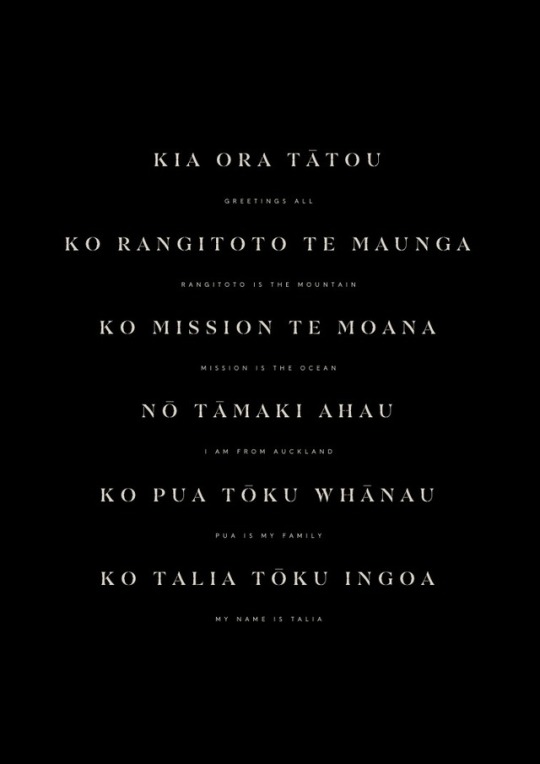
A Contemporary Pepeha?
Week 4: 20-22/3/19
One of the pieces of feedback we received from our pitch was to look at The Pepeha Project. This is a website that wants to encourage learning Te Reo Māori through building your own pepeha.
A pepeha is an oratory statement to introduce yourself by acknowledging the status of your tribal mountain, river, canoe and meeting house. This tradition is rooted in Māori tikanga (way of doing) which is based on “notions of ancestral continuum and the passing down of codes, which embed land, sea, and sky within our consciousness.” (Shea Murphy, & Gray, 2016)
We were inspired by how Māori culture frames identity within a wider context of connections and whakapapa, which includes people, landmarks and environments.
Something that stood out to us from The Pepeha Project was the statement Koinei tā Aotearoa whakaniki/This is how New Zealand introduces itself. Regarding our topic, this made us think:
How would we introduce ourselves as a nation?
What would New Zealand’s pepeha be?
Or even, what would a multicultural New Zealand pepeha be?
This raised other question such as: how has pepeha evolved overtime? And what does a contemporary pepeha look like?
The Pepeha Project (Pepeha, 2018) is a contemporary example. This work is very text-based and in ways seemed quite prescribed like a fill in the blanks exercise. Thus, it doesn’t acknowledge the different types and approaches to structuring a pepeha.
Another contemporary example is Areta Wilkinson’s exhibition Whakapaipai – Jewellery as Pepeha. The work is about treasuring taonga (wearable personal adornment) and the knowledge transfer that surrounds them. Thus, it is interesting to see how she translated pepeha as an oral tradition into physical artefacts.
“The nature of pepeha announces, distinguishes, identifies and locates. Jewellery as pepeha is located in the remnants of memory and knowledge, in whakapapa and whenua, in the legacies of belongs of sustenance and in the spirit of continuum – taoka tuku iho.”
(Te Rūnanga o Ngāi Tahu, 2014)
Overall, forming a New Zealand pepeha proves a big challenge, and one that needs to be done respectfully keeping in mind the language and cultures that surrounds it. Perhaps it would be beneficial to reach out to someone in the Māori community to talk about concepts around a national and contemporary pepeha.
References/Bibliography
Pepeha (2018). Retrieved March 19, 2019, from http://pepeha.nz/
Robb, A., (2017). What is the role of Pākehā in supporting the reo Māori? [Opinion] Retrieved on March, 22, 2019, from https://e-tangata.co.nz/reo/what-is-the-role-of-pakeha-in-supporting-te-reo-maori/
Shea Murphy, J., & Gray, J. (2016). Ko Mitimiti ahau, I Am (of) the Place, Mitimiti. Dance Research Journal, 48(1), 33–36. Retrieved from http://ezproxy.aut.ac.nz/login?url=http://search.ebscohost.com/login.aspx?direct=true&db=s3h&AN=114918080&site=eds-live
Te Rūnanga o Ngāi Tahu. (2014). WHAKAPAIPAI: Jewellery as pepeha. Retrieved on March 22, 2019, from https://ngaitahu.iwi.nz/our_stories/whakapaipai-jewellery-pepeha/
University of Otago. (n.d.) Māori ki Te Whare Wananga o Ōtākou - Maori at the University of Otago: Mihi – Introductions. Retrieved on March 22, 2019, from https://www.otago.ac.nz/maori/world/te-reo-maori/mihi-introductions/index.html
4 notes
·
View notes
Text
Growing up macklemore intro guitar

#Growing up macklemore intro guitar how to
#Growing up macklemore intro guitar series
In the autumn of 2009, Sheeran began studying music at the Academy of Contemporary Music (ACM) in Guildford, Surrey as an undergraduate at the age 18, but left without permission in the same year to support hip-hop artist Just Jack. He also opened for Nizlopi in Norwich in April 2008, after being one of their guitar technicians.
#Growing up macklemore intro guitar series
In 2008, he auditioned for the ITV series Britannia High. He moved to London in 2008 and began playing in small venues. He has been friends with fellow English singer, Passenger, since he was 15, with the two playing the same gig in Cambridge. Sheeran began recording music in 2004 and independently released his first collection of work Spinning Man. Sheeran performing at the Ipswich Arts Festival in July 2010 Sheeran is a second cousin of Northern Irish broadcaster Gordon Burns, who hosted the British game show The Krypton Factor. He is a patron of Youth Music Theatre UK (now renamed British Youth Music Theatre) and of Access to Music, where he studied Artist Development. He successfully auditioned for Youth Music Theatre UK in 2007 and joined their production of Frankenstein in Plymouth. He was accepted at the National Youth Theatre in London as a teenager. A 2004 school report described him as a "natural performer", and his classmates also voted him "most likely to be famous".
#Growing up macklemore intro guitar how to
Sheeran sang at a local church choir at the age of four, learned how to play the guitar at age eleven, and began writing songs while at Thomas Mills High School in Framlingham. His parents ran Sheeran Lock, an independent art consultancy, from 1990 to 2010. John is an art curator and lecturer, and Imogen is a culture publicist turned jewellery designer. His paternal grandparents are Irish, and Sheeran has stated that his father is from a "very large" Catholic family. Sheeran's parents, John and Imogen, are from London. He has an older brother named Matthew, who works as a composer. In December 1995 he moved with his family from Hebden Bridge to Framlingham in Suffolk. His father was a curator at Cartwright Hall in Bradford and his mother worked at Manchester City Art Gallery. His early childhood home was on Birchcliffe Road in nearby Hebden Bridge. Įdward Christopher Sheeran was born in Halifax, West Yorkshire, England on 17 February 1991. The castle and his upbringing in Framlingham is the subject of his 2017 single " Castle on the Hill". Early lifeįramlingham Castle in Sheeran's home town. An alumnus of the National Youth Theatre in London, Sheeran's acting roles include appearing in the 2019 film Yesterday. Beginning in March 2017, his ÷ Tour became the highest-grossing of all time in August 2019. Globally, Spotify named him the second most streamed artist of the decade. In December 2019, the Official Charts Company named him artist of the decade, with the most combined success in the UK album and singles charts in the 2010s. He has 84.5 million RIAA-certified units in the US, and two of his albums are in the list of the best-selling albums in UK chart history: × at number 20, and ÷ at number 34. Sheeran has sold more than 150 million records worldwide, making him one of the world's best-selling music artists. Released in 2019, his fourth studio album No.6 Collaborations Project debuted at number one in most major markets, and spawned three UK number one singles, "I Don't Care", "Beautiful People" and "Take Me Back to London". The world's best-selling artist of 2017, he was named the Global Recording Artist of the Year. His fourth single from ÷, "Perfect", reached number one in the US, Australia and the UK, where it became the Christmas number one in 2017. By March 2017, Sheeran had accumulated ten top 10 singles from ÷ on the UK Singles Chart, breaking the record for most top 10 UK singles from one album. He also became the first artist to have two songs debut in the US top 10 in the same week. The first two singles from the album, "Shape of You" and "Castle on the Hill", broke records in a number of countries by debuting in the top two positions of the charts. Sheeran's third album, ÷ (pronounced "divide"), was released in March 2017, and was the best-selling album worldwide of 2017. A single from ×, "Thinking Out Loud", earned him the 2016 Grammy Awards for Song of the Year and Best Pop Solo Performance. In the same year, × won Album of the Year at the 2015 Brit Awards, and he received the Ivor Novello Award for Songwriter of the Year from the British Academy of Songwriters, Composers and Authors. It was named the second-best-selling album worldwide of 2015. Sheeran's second studio album, × (pronounced "multiply"), was released in June 2014. In 2012, Sheeran won the Brit Awards for Best British Male Solo Artist and British Breakthrough Act. It contained his first hit single " The A Team". Sheeran's debut album, + (pronounced "plus"), was released in September 2011 and topped the UK Albums Chart.

0 notes
Text
Master in Design Engineering Colleges
Strate is one of the best transportation design college/school in India offering a 5-year Masters in Automotive Design/Transportation Design. Learn more about automobile designing course eligibility, fees, etc. Strate - Master in Design Engineering
The Strate masters in design engineering consists of four years of study and an internship. During the third year, students specialize in one of three majors: industrial design, environmental design, or urban design. Students also do their first six-month internship. The fifth year is reserved for the final internship in France or abroad, or to prepare the diploma. The program's unique structure has earned international recognition. In June 2017, five large companies and two major academic research laboratories partnered with Strate. The 4 year research project involves these partners.
The University of Strate, product design course in india is a postgraduate degree in design engineering. This program offers students the opportunity to combine behavioural and management sciences with advanced engineering skills. This modern entrepreneurial university is recognized for its innovative business ideas and engineering skills, and has launched over 700 spin-off companies in its 50-year history.
The Strate design program is aimed at graduates with a proven affinity for design and the potential to accelerate their professional development. The school also looks for students with professional skills such as Dutch and English language proficiency, as well as good interpersonal skills, collaboration skills, and initiative. Applicants with prior knowledge of road design may also be considered for the programme. The application procedure includes an interview and submission of a curriculum vitae, a list of references, and publications.
The University of strate is a public technical university in the india. It has a long history of developing design methodologies and integration of design theories into its education and research. It has been recognized as the best technical university in the India.
A Masters in design engineering from the strate School of Art develops the skills and knowledge of future employers. The curriculum is taught in a studio environment, with project-based learning. It includes access to modern prototyping and manufacturing facilities. It also teaches students to think critically and creatively.
The School has a long history of producing some of Scotland's most renowned contemporary artists. The strate has produced more than 30 percent of the nominees for the Turner Prize since 2005, and five winners since 2011. The school also offers non-degree art and design classes in disciplines such as fine-art photography, painting, sculpture, printmaking, textile design, product design engineering, jewellery design, interior design, communication design, and architecture.
The strate school campus is in the bangalore, a scenic area that provides an inspiring setting for study. The school's transformation design course encourages students to think critically about design and how it can help improve society. It also hosts an annual Winter School, which brings together students from around the world to network and share knowledge.
Strate master in design engineer course offers you the chance to specialize in a particular field and hone your skills. This course will help you understand how to create innovative products and systems. You will learn about advanced design and engineering software. You will also develop your analytical skills and apply them to solve real world problems.
#product design course in india#Product Design Course in Bangalore#product design colleges in bangalore#masters in product design india#product design courses#masters in product design
0 notes
Text
MIKALA DWYER - ARTIST STUDY:
Mikala Dwyer Artist:
“Mikala Dwyer’s practice is predominantly installation-based, in which she constructs idiosyncratic, personal spaces within the conventional architecture of the gallery, using materials that have a strong association with the body.” - (MCA).

Mikala Dwyer, The Silverings, 2022, Museum of New Zealand Te Papa Tongarewa, Wellington (Above).

Mikala Dwyer, A weight of maybes, 2017 | Unfinished Business: Perspectives on art and feminism, Australian Centre for Contemporary Art, Melbourne (Above).
“Mikala Dwyer is interested in ritual, sexuality, magic, memory and history. Influenced by early 20th-century art movements, including dada, constructivism and arte povera, her work pushes at the traditional limits of performance, sculpture and installation. She integrates all kinds of materials – from plants, mirrors, trinkets, fabric and perspex to clay, helium, wood, paint and wool – in different combinations, exploring the relationship between viewers and objects, and the everyday visible and invisible forces that surround us” (MCA).

Mikala Dwyer, The Divisions and the Subtractions, 2017 | A shape of thought, 2017, Art Gallery of New South Wales, Sydney (Above).

“Untitled (1995) ^^^^ is a pivotal early work from this period. The soft fabric suggests the body; however, the uniform placement of the six forms references hard-edged minimal sculpture of the mid 1950s. This fusion of sensuality with formality is a distinguishing characteristic of Dwyer’s art” (MCA).
“Dwyer has incorporated elements of the feminine masquerade in a number of her works, working with fabrics and accessories strongly associated with dressing up and adornment, such as organza, pantyhose and makeup. Through these materials she conjures associations with the body, with a particular kind of feminine identity and with the rites of passage that create that identity. In No, not ever, the range of nail polish colours in the titles is a reminder of the pleasures of choice in creating an identity, in expressing a social persona, and of accessorising an outfit. The nail polish paintings create an empathy between artist and viewer, a sharing of experience about what it is to create a work of art – whether it be a painting on a wall, or (always a work in progress), ourselves” (MCA). - below

No, not ever, 1994 (Above).

No, not ever - pearly grape - true confessions (Oleander), (Above).
monochromes painted in nail polish.

Recent old work, 1996 (Above).
I really really loved looking at Dwyer’s work - and some of the writing done considering her work has helped me verbalise some of the developed aspects of my own practice.
This idea of creating personal spaces - something Dwyer achieves through her installation work (MCA) - is something that I was interested in last semester, but the installation of my work this semester, I think could realise this aspect better, and further push this idea of domestic/private/public space.
The MCA also wrote how this is reinforced by Dwyers use of materials which have strong connections to the body - something that I have developed on since last semester, now using re-worked clothing, jewellery etc.... That same text also speaks of materials being soft, or draped, evokes a sense of the body.
“The soft fabric suggests the body” & “this fusion of sensuality with formality”
There was also a mention of arte povera and history - another element I connect to my own practice, but something to re visit and further flesh out I think...
The most invigorating part of this artist study was the commentary on Dwyers work in an exhibition that showed at the Biennale - No, not ever (1994). Nail Polish works - I found this exciting as it spoke of the use of ‘elements of the feminine masquerade’ - being used as a medium for artwork. Kind of speaks to the performance of gender , something I wrote about in my final research essay last semester... and something that I am still super interested in, and is starting to flesh out in my work.
“Dwyer has incorporated elements of the feminine masquerade in a number of her works, working with fabrics and accessories strongly associated with dressing up and adornment, such as organza, pantyhose and makeup. Through these materials she conjures associations with the body, with a particular kind of feminine identity and with the rites of passage that create that identity” (MCA).
This really got me thinking about identity and how it fits within my work - because it has always been a part of it, I think some more focus on these aspects could be beneficial.
I definitely resonate with this idea of using feminine objects and materials, and in my case processes, deliberately as a medium - to redefine or value, or simply to use for art.
- feminist critique on this idea of femininity -
Links: http://www.mikaladwyer.com/
https://www.mca.com.au/artists-works/artists/mikala-dwyer/
1 note
·
View note
Text
Meeeow! Why are we obsessed with cats?
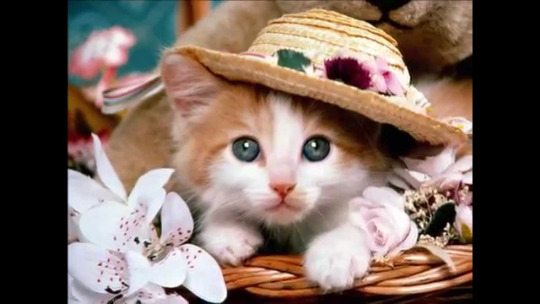
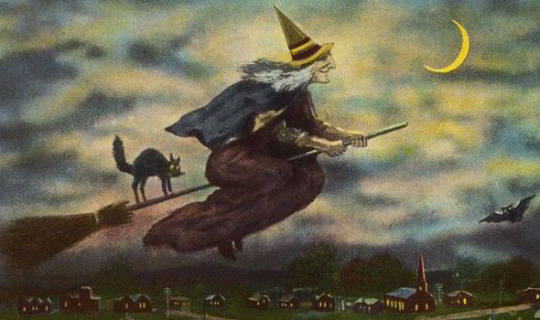
Claws out! Why pop culture clings to the crazy cat lady
Lucy Jones, The Guardian newspaper
Mon 16 Apr 2018 16.48 BST
For years, women with cats have been portrayed as lonely, sexless and eccentric – but why does this stereotype endure? And can millennial ailurophiles reclaim the purr-jorative?
Did you hear the story about the old woman from Ohio who was arrested for training her 65 cats to steal her neighbour’s stuff? The Columbus police department found thousands of dollars’ worth of jewellery in the 83-year-old lady’s house and discovered she taught the cats to bring back “anything that shined”.
The news story went viral at the end of last year. How do you picture her? Unkempt hair, dressing gown and slippers, living alone, rarely leaving the house? The “crazy cat lady”, in other words. In fact, the story was fiction on a satirical website, but people bought it and shared the story thinking it was real.
The crazy cat lady is a common, recognisable trope in contemporary culture: think of Eleanor Abernathy in The Simpsons. After a promising career in medicine and law, she experiences burnout, starts drinking and gets a cat. Next minute, she’s talking gibberish, looking dishevelled and throwing her army of felines around. Then there’s Robert De Niro’s predictably bonkers elderly Christmas cat lady in a 2004 Saturday Night Live skit: she “had dreams and then she was kicked by a horse and now she has cats. The end!”
The younger version of the stereotype is usually associated with being single, kooky and weird; after her relationship with Carol Burnett comes to a head, 30 Rock’s Liz Lemon acquires a cat. “I can fit Emily Dickinson’s whole head in my mouth,” she tells a concerned Jack Donaghy. You can even buy a Crazy Cat Lady action figure online, complete with deranged, staring eyes.
To understand why this trope exists – and why it may be on its last legs – let’s scoot back to the middle ages and the earliest perceptions of women and their cats. Even before witch-hunts, cats had a bad rep in the western world – with associations with heretical sects and the devil. Medieval types conflated feline sex lives with lustful, sinful, female sexuality: cats were seen as “lecherous animals that actively wheedled the males on to sexual congress”, according to the historian James Serpell. Although, in recent pop culture, cat lady has evolved into shorthand for a lonely, sad, sexless woman. Too sexy, not sexy enough: can’t please ’em.
The earliest cat ladies in the west were, of course, witches. In Malleus Maleficarum, the landmark medieval treatise on witchcraft, a 13th-century folk story is recounted, whereby three witches turned themselves into cats, attacked a man on the street and accused him of assault in court, showing the marks on their bodies. From then on, witches were believed to have cats as familiars, or to change into felines at night.
Why would cats get such a satanic rep? We can only guess. Cats are mysterious. They come and go. Unlike dogs, they refuse to obey and be domesticated. They’re nocturnal. The Ancient Egyptians worshipped Bastet, a woman with a head of a cat. Although the Bible does not specifically mention cats, early Christian pilgrims were highly suspicious of other religions, and they deemed the black cat to be so demonic that being seen with one could be punishable by death.
Although the 18th century saw people beginning to question superstitions – such as the belief that a woman’s wart was a teat suckled by Satan – negative connotations of the relationship between cats and women remained. The Victorians switched witches for old-maid stereotypes – for single women without children: “Old maids and cats have long been proverbially associated together, and, rightly or wrongly, these creatures have been looked upon with a certain degree of suspicion and aversion by a large proportion of the human race,” wrote a journalist in the Dundee Courier in 1880. The Old Maid card game was often illustrated with a dour woman and her cat, the “friend of the friendless”, as it was described at the time. In the 1900s, anti-suffragette propaganda used images of cats to portray women as silly, useless, catty and ridiculous in their attempt to enter political life.
The inception of the “crazy” moniker is harder to pin down, but its connotations of hysteria are an old gender stereotype. Added to this, the extreme end of the modern “crazy cat lady” stereotype has more than a few cats, which is unusual. Eleanor Abernathy, for example, has cats dripping off her: she is, essentially, portrayed as a mentally ill, alcoholic, compulsive hoarder.
There may be some truth in the idea that animal hoarding is more common in women. A study in Brazil found that, while generalised hoarding disorder affects men and women equally, nearly three-quarters of animal hoarders were women. Since 2013, the Diagnostic and Statistical Manual of Mental Disorders classifies compulsive hoarding as a psychiatric disorder, with animal hoarding as a subtype.
Another recent theory is to do with a parasite called toxoplasma gondii. This tiny critter infects rats and mice and changes their behaviour by, scientists believe, creating an attraction to cat urine, so it can wind up in the stomach of a cat, where it reproduces. It also infects between 30% and 60% cent of people. Scientists are exploring evidence that toxoplasmosis could create behavioural changes in people, leading to lots of excited articles wondering if the parasite is a clue to explaining the phenomenon of “crazy cat lady”. The parasite contains an enzyme that creates dopamine, which is associated with risky and impulsive behaviour, among other things, but so far the data is inconclusive.
But, really, the concept of the crazy cat lady tells us more about societal perceptions of women than anything else. It has long been a pejorative term and a device for transferring shame and judgment on women who challenged traditional roles, or were hard to domesticate and keep in line. Here is the co-creator of Batman, Bob Kane, explaining his creation of Cat Woman: “I felt that women were feline creatures and men were more like dogs. While dogs are faithful and friendly, cats are cool, detached and unreliable … cats are as hard to understand as women are,” he said. “You always need to keep women at arm’s length. We don’t want anyone taking over our souls, and women have a habit of doing that.”
But millennial ailurophiles have had enough. Over the last few years, there have been multivalent efforts to debunk the crazy cat lady stereotype and project a positive view of women and their cats. Pussy is striking back.
From glossy fashion magazines celebrating the feline-human relationship – Cat People, Puss Puss – to Taylor Swift and Katy Perry’s unashamed adoration of their feline pets, the stereotype is being recalibrated. CatCon Worldwide, a new conference celebrating cat culture, has, as its core value, the desire to “change the negative perception of the crazy cat lady and prove that it is possible to be hip, stylish, and have a cat”.
The book Cat Lady Chic (2012) offered elegant images of cat-owners Audrey Hepburn, Georgia O’Keeffe, Diana Ross and Zelda Fitzgerald as an antidote to the Eleanor Abernathy archetype. And Girls & Their Cats, a sophisticated series of photographs of women and their feline companions, was created by Brooklyn-based fashion photographer BriAnne Wills to help dismantle the stereotype.“It just wasn’t representative of any of the cat ladies I personally knew, who are all independent, cool, career-driven women who really love their cats,” she said. “Also, there are more than a million cats euthanised each year so if women (and men) are afraid to adopt because of negative stereotypes it definitely hurts cats in the long run.”
In the memorable short story Cat Person (2017), Kristen Roupenian inverts the cat lady trope by giving her male protagonist, Robert, a couple of pet cats. She employs the presence of Robert’s felines as a symbol that Margot uses to construct her image of him. “We decide that it means something that a person likes cats instead of dogs,” said Roupenian in an interview. But there is something sinister going on. Margot never sees the cats, and wonders if Robert has lied about them. So what is it about pretending to have cats that might endear Margot to him in a sexual setting? Is he using his cats to lure her in?
But perhaps the moment the crazy cat lady motif truly jumped the shark was with the song Buttload of Cats on an episode of the television series Crazy Ex-Girlfriend earlier this year. Rebecca Bunch walks herself down to the Lonely Lady Cat Store. “The smell is overwhelming inside / This is the future smell of my house / It’s the smell of my dreams that have died,” she sings. “When you’re a permanent bachelorette / It’s mandatory that you go out and get / A buttload of cats / Oh, yeah!”
The song made a mockery of the hysteria projected on women who own cats. So is the notion of the crazy cat lady over? Wills believes there is still work to be done to change perceptions, but she hopes that her photography project will help. “It is 2018,” she says, “and women are tired of defending themselves.” And their love for their cats.
AND I LOVE CATS TOO. ESPECIALLY SIAMESE (but my dog hates them)
7 notes
·
View notes